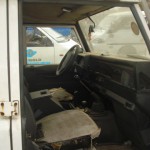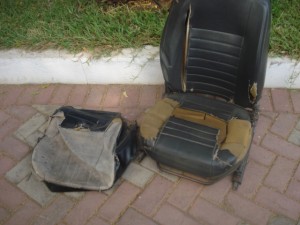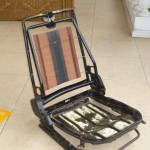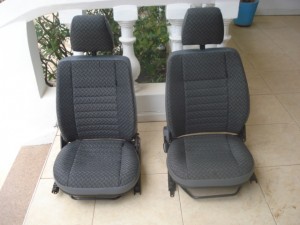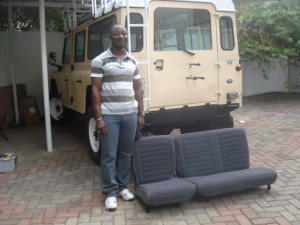When we bought the Defender in February last year the original seats were in a pretty sorry state.  The original covering on the front seats had become so worn and torn someone had recovered them using what appears to have been a combination of another cover patched with old bags from the Takoradi Flour mill. The seat frames were starting to rust and only adjusted forward and back or tilted with a great deal of encouragement, if at all.  The back seats were/are very simple bench type seats, with a vinyl cover that was worn and torn, but still intact. Ditto for the side facing seats mounted on the wheel wells in the cargo bay.
The restored Land Rovers that come out of Opere’s shop under the tree are done with a seat vinyl that we did not find to be terribly attractive, thus one of the reasons why we wanted to manage the restoration ourselves was to be able to exercise greater control over the design of the interior finish. For the front seats we decided to import refinishing kits from a place called Exmoor Trim in England, which specializes in custom items for Land Rovers. come complete with new foams and a choice of attractive, quality covers. We took out all the seats before we delivered the Defender to the paint shop, so we could start that part of the project. That proved to be a smart thing to do as the painting took much longer than we expected.
The best part was tearing off the old covers and seat foams. These were quite shot, although given the heavy use and poor condition of the covers, the quality of th original foams had to be good for them to have remained as intact as they were. Once we got the metal seat frames stripped we cleaned off any rust and grime from around the base, which is wher the slide and tilt mechanism is, which was all re-oiled and restored to good working order.  In another sign of wear was visible in the base panel of the passenger seat, which had come detached from the frame at the front and bent so the panel, which is supposed to attach to the top front of the base seat frame, had slipped down below the frame. That meant there was nothing supporting the base when someone was sitting on it. No wonder it did not slide back and forth very well. A quick reweld courtesy of Paani fixed that problem.   We then repainted the base of the metal seats with some of the exterior black paint that Sikkens had used for the bumpers.
Laura and I installed the new foam cushions and cover kits with the aid of the Exmoor on-line instruction video. Somehow the video made it look and sound easier than it actually was, there were moments when we thought we had too much foam and not enough material, but of course is it supposed to be a firm fit and after enough pulling and tugging the zips all zipped and the clips all clipped.  The final product is attractive and, most importantly, very comfortable.
The second row bench type seats presented a different challenge. I had wanted to replace these with back seats from a Discovery I, an early version of another, less utilitarian Land Rover model that began production about tweny years ago, in order to gain comfort and leg room. Unfortunately we were not able to find any Disco I seats for a reasonable price so we decided to simply restore the original bench seats.  We are not sure at this point we will take the back seats on the expedition, much of the space may be better used from storage. It is a 70/30 split so we may just take the 30% part, but we need seats in Accra.   Rather than buy Exmoor kits we hired a local upholsterer that Francis had recommended named Michael Deborah, to put in some new foam and recover them. Michael brought by some material samples (one of the beauties of doing a project like this in Accra is the service people come to you, you don’t have to go to them) and we chose a neutral gray cotton to complement the Exmoor front seats and other interior finishes. We were expecting he would just put the fabric on smooth as it was on the original vinyl covered back seats, but he designed them with horizontal bars and grey vinyl backs to replicate the design of the Exmoor front seats and it looks very nice. I have since asked Michael to recover the “cubby box” (the glove box that goes between the front seats) in the same gray vinyl to freshen that up and pull it all together.
The Defender cargo bay area also has bench seats that sit sideways over the wheel wells, with all these seats the 110 can easily accommodate 9 passengers.  However, our plan calls for the cargo area to be converted to storage so we do not need any seats there, and were one of the first things I took out and before I had Paani fill all the mounting bracket holes as part of the body work. We will not bother redoing those seats, maybe I will ask Opere if he can find a use for them somewhere.
Next, getting the soundproofing in……
